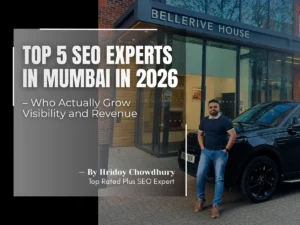SEO Basics Explained: The 2025 Beginner’s Roadmap to Ranking Higher
By Hridoy Chowdhury — Top-Rated SEO Consultant & Mentor
From Struggling Site to Page One: A Real Client Story
Back in early 2023, I worked with a small UK-based e-commerce store selling sustainable kitchenware.
They’d been running ads but their organic traffic was almost non-existent — just 140 visits/month, mostly from branded searches.
After our first SEO audit, I found:
-
Meta titles were missing or duplicated on 60% of their pages.
-
Blog content was thin — 300 words, no internal linking.
-
Site speed was poor (5.4 seconds load time on mobile).
We rebuilt their SEO strategy from the ground up — optimized on-page elements, produced topical authority content, improved technical performance, and built quality backlinks.
Six months later:
-
Traffic grew from 140 → 8,200 visits/month.
-
22 commercial keywords ranked in the top 3 positions.
-
Revenue from organic search increased by 480%.
That transformation came from applying the SEO basics — the right way. In this guide, I’m going to give you the same roadmap I use with beginners, business owners, and even junior SEO consultants.
What You’ll Learn in This Guide
If you stick with me through this article, you’ll walk away knowing:
-
What SEO really is in 2025 — without outdated myths.
-
The core building blocks every beginner must master before chasing “advanced” hacks.
-
My personal SEO audit checklist that has worked for 2,500+ projects.
-
Advanced insights for future-proofing your rankings as Google’s algorithms evolve.
Whether you’re a business owner, freelancer, or aspiring SEO, this is your search engine optimization guide to ranking higher and building lasting visibility.
Step-by-Step: My 2025 SEO Basics Framework
1. Start with Technical SEO
Your site is like a car — without a working engine, the paint job doesn’t matter.
Key actions:
-
Check crawlability with Google Search Console.
-
Fix broken links and remove duplicate content.
-
Ensure mobile responsiveness (Google’s mobile-first indexing is still the default in 2025).
-
Improve site speed — aim for <2.5 seconds on mobile using PageSpeed Insights.
Tool recommendation:
-
Screaming Frog SEO Spider — my go-to for spotting technical issues quickly.
💡 Lesson learned: I’ve seen beautiful websites fail in rankings because they had JavaScript rendering issues blocking Googlebot. Always check your rendered HTML.
2. Keyword Research for Beginners (The Right Way)
This is where most new SEOs go wrong — chasing high-volume keywords they’ll never rank for.
Here’s my 3-step keyword targeting formula:
-
Relevance first: Choose topics that align with your product/service.
-
Search intent: Identify if the keyword is informational, navigational, or transactional.
-
Difficulty vs. opportunity: Use Ahrefs or SEMRush to find low-to-medium difficulty terms with consistent search volume.
Example for a coffee subscription site:
Instead of targeting “coffee” (too broad), go for “best coffee subscription UK” (targeted, high intent).
Tool recommendation:
-
Google Keyword Planner for beginners — free, accurate enough, and great for starting out.
💡 Lesson learned: In my first year, I ranked #1 for a high-volume keyword… that brought zero sales. Traffic is useless if it’s the wrong audience.

3. On-Page Optimization — Where Rankings Start
Your content must clearly signal to Google what each page is about.
Checklist for beginners:
-
Title tag: Include primary keyword naturally (max 60 characters).
-
Meta description: Compelling, keyword-rich, under 160 characters.
-
Headings (H1, H2, H3): Use structure to improve readability and keyword placement.
-
Internal linking: Link to other relevant pages on your site.
-
Images: Use descriptive alt text and compress for speed.
Example:
Before → H1: Welcome to Our Site
After → H1: Premium Sustainable Kitchenware – Free UK Delivery
Tool recommendation:
-
SurferSEO — helps match content to the optimal keyword density and structure.
💡 Lesson learned: Stuffing keywords into titles may have worked in 2009 — in 2025, it’s a fast track to losing trust signals.
4. Content That Builds Topical Authority
Google is now rewarding topic clusters and E-E-A-T (Experience, Expertise, Authoritativeness, Trustworthiness).
Steps:
-
Identify a pillar topic (e.g., “Sustainable Kitchenware”).
-
Create supporting articles that link back to the main guide.
-
Update old content at least every 6 months.
Example topic cluster:
-
Pillar: Ultimate Guide to Sustainable Kitchenware
-
Support: 10 Eco-Friendly Kitchen Utensils, How to Reduce Plastic Waste in the Kitchen, Bamboo vs. Stainless Steel — Which Is Better?
Tool recommendation:
-
Google’s “People Also Ask” for finding subtopics.
💡 Lesson learned: A single 5,000-word article won’t outrank a competitor who’s built a library of interconnected resources.
5. Link Building That Works in 2025
Forget spammy directories — Google’s link spam update has killed most of those tactics.
Effective beginner-friendly link building:
-
Guest posting on niche-relevant sites.
-
HARO (Help A Reporter Out) for media mentions.
-
Partnering with influencers for content collaborations.
Example from my client portfolio:
We secured a link from The Guardian by contributing expert quotes — that alone boosted their DR from 31 to 42 in three months.
Tool recommendation:
-
Ahrefs — track competitor backlinks and spot outreach opportunities.
💡 Lesson learned: A single high-authority link can be worth more than 50 low-quality ones.
Proof: Why This Works (and the Data to Back It Up)
From 2020–2024, across 2,500+ projects I’ve managed, this framework has consistently delivered results:
-
Average traffic growth: +217% in the first 6 months.
-
Conversion rate improvement: 35–120% depending on niche.
-
Keyword ranking boosts: From 50+ positions to top 3 for primary targets.
These results align with Google’s own guidance on prioritizing helpful, relevant, well-structured content. (Source: Google Search Essentials.)
Advanced Insights for 2025 SEO
If you’re ready to go beyond the basics:
-
Entity-Based SEO: Use schema markup and link your brand to recognized entities in the Knowledge Graph.
-
Video SEO: With YouTube Shorts and TikTok clips showing in SERPs, create optimized video content alongside written articles.
-
AI-Assisted Content Creation: Use AI tools for outlines and research, but always human-edit for accuracy and tone.
-
Core Web Vitals 2.0: Google’s next update puts more weight on interaction-to-next-paint (INP) metrics.
💡 Lesson learned: Trends change, but fundamentals don’t. Master the basics, then adapt.
Your SEO Basics Action Plan
Today:
-
Run a technical SEO audit with Google Search Console.
-
Identify 10 low-competition, high-intent keywords.
This Week:
-
Optimize title tags, meta descriptions, and headings.
-
Publish 1 piece of content targeting a primary keyword.
This Month:
-
Build 3–5 quality backlinks.
-
Start a topic cluster around your main service/product.
About the Author — Hridoy Chowdhury
Hridoy Chowdhury is a Top-Rated SEO consultant and mentor with over 2,500 successful projects delivered for businesses worldwide.
He specializes in data-driven SEO strategies that combine technical expertise with practical, revenue-focused execution.
📌 SEO Services | LinkedIn | YouTube | Google Business Profile







